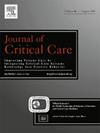Strategic analysis of apnea testing to determine brain death with PaCO2 and pH targets in China: A multi-center retrospective study
IF 3.2
3区 医学
Q2 CRITICAL CARE MEDICINE
引用次数: 0
Abstract
Background
Brain death (BD) means the irreversible loss of whole brain function. Apnea testing (AT) is crucial when determining BD. AT criteria has been updated to combine PaCO2 and pH rather than an individual PaCO2 target. In this study, we aimed to explore the influencing factors of AT under the new standard to reduce non-diagnostic results and complications.
Method
Data were retrieved from five hospitals from 2018 to 2023 in China. Samples were grouped based on AT duration, temperature, pre-PaCO2, oxygenation index (OI, PaO2/FiO2) respectively to compare. Multivariate linear regression analysis analysis was used to identify related clinical indicators.
Results
We included 620 BD patients that underwent AT. Diagnostic rate for dual AT targets was 92.4 %, which is 3.4 % lower than that under conventional criteria. Diagnostic rate no longer improved for AT duration (time disconnected from the ventilator) that lasted longer than 9 min (χ2 = 0.049, p = 0.826), but the incidence of severe hypercapnia (PaCO2 > 80 mmHg) and severe acidosis (pH < 7.10) increased. The pre-PaCO2 ≥ 40 mmHg group had shorter required durations (p = 0.029), and higher diagnostic rate (p = 0.041) than pre-PaCO2 < 40 mmHg group. The duration could last significantly longer in OI ≥200 than OI < 200 group (8.675 ± 0.077 min vs. 8.063 ± 0.165 min; p < 0.001). Weight, heart rate baseline, pre-pH, pre-PaCO2 and duration were related to the final PaCO2 and pH.
Conclusion
For most patients, 7–9 min of AT duration is appropriate to reach dual diagnostic targets. Modulating the baseline level of PaCO2 (≥40 mmHg), pH and OI (≥200) can help reduce non-diagnostic results and improve the safety of AT implementation.
中国呼吸暂停检测以PaCO2和pH指标判断脑死亡的策略分析:一项多中心回顾性研究
脑死亡(BD)是指整个大脑功能的不可逆转的丧失。在确定BD时,呼吸暂停测试(AT)是至关重要的。AT标准已更新为结合PaCO2和pH值,而不是单独的PaCO2目标。在本研究中,我们旨在探讨新标准下AT的影响因素,以减少非诊断结果和并发症。方法检索2018 - 2023年中国5家医院的数据。分别根据AT时间、温度、预paco2、氧合指数(OI、PaO2/FiO2)进行分组比较。采用多元线性回归分析,确定相关临床指标。结果我们纳入了620例接受AT治疗的BD患者。双AT靶的诊断率为92.4%,比常规标准低3.4%。当AT持续时间(脱离呼吸机的时间)超过9 min时,诊断率不再提高(χ2 = 0.049, p = 0.826),但严重高碳酸血症(PaCO2 >;80 mmHg)和严重酸中毒(pH <;7.10)增加。paco2≥40 mmHg组所需时间短(p = 0.029),诊断率高(p = 0.041);40 mmHg组。OI≥200的患者持续时间明显长于OI <;200组(8.675±0.077 min vs. 8.063±0.165 min);p & lt;0.001)。体重、心率基线、预ph值、预PaCO2和持续时间与最终PaCO2和ph值有关。结论对于大多数患者,7 - 9min的AT持续时间可以达到双重诊断目标。调节PaCO2(≥40 mmHg)、pH和OI(≥200)基线水平有助于减少非诊断结果,提高AT实施的安全性。
本文章由计算机程序翻译,如有差异,请以英文原文为准。
求助全文
约1分钟内获得全文
求助全文
来源期刊

Journal of critical care
医学-危重病医学
CiteScore
8.60
自引率
2.70%
发文量
237
审稿时长
23 days
期刊介绍:
The Journal of Critical Care, the official publication of the World Federation of Societies of Intensive and Critical Care Medicine (WFSICCM), is a leading international, peer-reviewed journal providing original research, review articles, tutorials, and invited articles for physicians and allied health professionals involved in treating the critically ill. The Journal aims to improve patient care by furthering understanding of health systems research and its integration into clinical practice.
The Journal will include articles which discuss:
All aspects of health services research in critical care
System based practice in anesthesiology, perioperative and critical care medicine
The interface between anesthesiology, critical care medicine and pain
Integrating intraoperative management in preparation for postoperative critical care management and recovery
Optimizing patient management, i.e., exploring the interface between evidence-based principles or clinical insight into management and care of complex patients
The team approach in the OR and ICU
System-based research
Medical ethics
Technology in medicine
Seminars discussing current, state of the art, and sometimes controversial topics in anesthesiology, critical care medicine, and professional education
Residency Education.
 求助内容:
求助内容: 应助结果提醒方式:
应助结果提醒方式:


